
We’re staying at a yoga retreat center called Sach’a Munay, near the top of the Sacred Valley. Sach’a Munay is Quechua for beautiful or loving tree, indicating the deep connection to the natural world of this indigenous culture. Our group of 18 participants and 3 guides walks up the stone pathway, lined with flowers of every color and terraces with inviting wooden benches in tiny gardens. We are led into a large building that houses the kitchen and dining room downstairs and spacious writing area upstairs. Winded from climbing the hill, we are now at about 11000’ elevation. Everything has a natural, organic feeling with white stucco walls and wood floors and furniture. I love the way the wooden structural components are exposed in the ceiling and walls- the feeling is simple, elegant, and calming. I meet my roommate, Carol and we immediately find we have much in common, including birthdays just two weeks apart (we both are celebrating turning 60 with this adventure!). Across a green lawn lined with stone walkways and walls is the yoga room- a large round building incorporating sacred geometry in its design with half of the ceiling in glass so you can see the towering mountains above. During one heavy rainstorm the peaks are dusted with snow in the morning. My eyes are constantly drawn up to view the steep mountains. The Incas believed they are spirits, called apus, and I swear I could feel their protective qualities towards those nestled in the Sacred Valley below. Many of the slopes are dotted with holes that are tombs from ancient peoples, robbed by the Spaniards (and others) who were looking for gold and silver treasures buried with the dead so they could take them along into the next world. Under the heated floor lie selenite crystals, which emit healing, centering energy, and in the center is a round glass window where you can look through the floor to see several huge crystals. Magical!! We also meet four friendly dogs that watch over the property and love to have their stomachs and heads rubbed- they provide a lot of comfort for those of us who are missing our 4 legged family members!
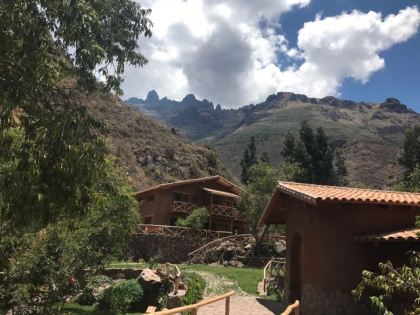
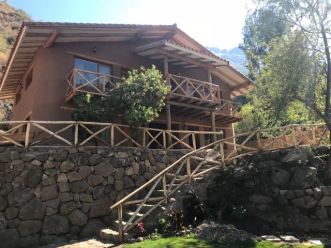
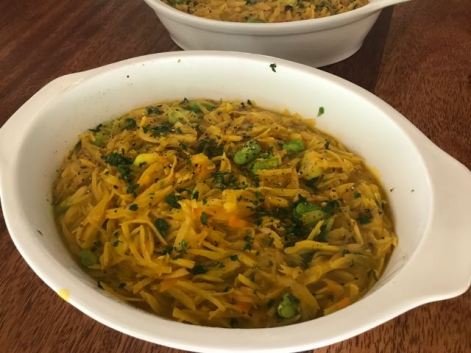
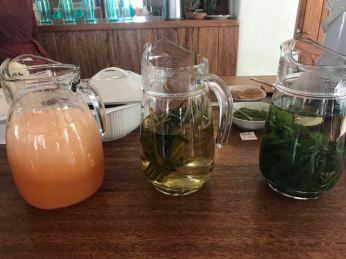
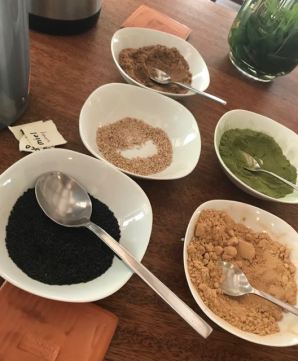
We are soon introduced to the delicious, healthy food produced by the friendly staff at Sach’a Munay. Meals feature lots of vegetables, fresh fruits, roasted chicken or fish, a variety of soups, salads from their garden, fresh teas and fruit drinks, and a selection of seeds and powders for toppings, including ground coca leaves (for altitude sickness and a mild stimulant), maca (for strength and vitality), and ground linseed (for digestion)- and no alcohol or sugar. In other words, very healthy! We are often served produce we don’t see in the US- like many different kinds of potatoes and the large kernels of corn they love to roast or add to soups and salads. For each meal we sit at large tables, so I make sure to sit by different people each time in order to get to know everyone in the group. Laura, the leader of our group, says her favorite part of these writing workshops is watching the community evolve. Setting that intention, along with agreeing on some policies to instill a sense of safety and sharing intimate stories from Laura’s writing prompts, provide a foundation for us to go deep with compassion and love for each other. Soon we have created a caring, connected community. Laura also gives us some other instructions at our first writing group: take a risk each day, make a gratitude list of three things each night before going to sleep, and take ten breaths when you experience joy or happiness in order to ruminate on the positive rather than the negative. We are also encouraged to connect to Mother Earth: for example when you take a drink of water, share a drop with the earth. These are lessons to help us break habitual patterns, but to me they also represent the sense of reverence and connection that I see in the Peruvian culture here in the Sacred Valley.
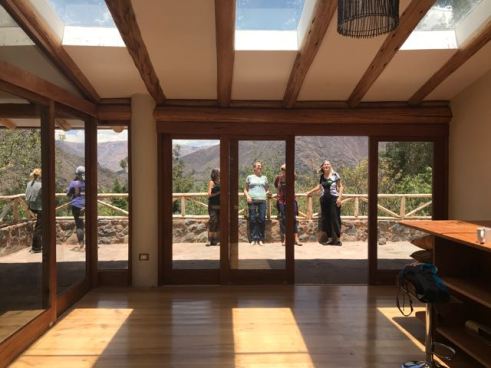
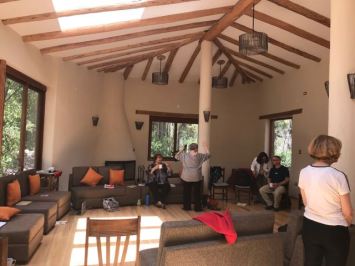
Our first writing assignment is to go for a walk with the little notebooks Laura gave us and record as much sensory detail as possible. I choose to walk into the neighboring village. Here are the results of my observations: As I leave Sach’a Munay I see 23 white plastic bags sitting in the driveway, tied up but with bright colors poking out- red bell peppers, dark green beans, sage-green corn husks, fat orange carrots, speckled green and yellow squashes, and some kind of dark-skinned root with white flesh (maybe taro?). Two stacks of 6 flats each of brown eggs in turquoise cartons are tied together with yellow ribbons. Our food delivery must have just been dropped off! I hear thunder booming overhead and look up to see thick clouds, some a darker grey. The narrow, windy dirt road is lined with a solid 5-6’ high wall of dark brown stones that provides a barrier between properties. At one place the wall is gone and instead several tree stumps with protruding roots are stacked, also providing a solid barrier. Make do with the resources you’ve got- a good permaculture principle! Stacks of cocoa brown adobe bricks with bits of golden straw poking out are piled up in one yard. Most of the houses are made with these bricks and roofs of terra cotta tiles, giving a rich, earthy coloring to towns and villages- so much more appealing to me than the concrete, asphalt, and synthetic materials most land in US cities are covered with. These components are even biodegradable!! Most back yards have rows of 1-2’ tall brilliant green corn stalks and a few multi-colored chickens poking around. Rows of dark dirt are plowed by hand following the contour of the hilly land. One property has a corrugated aluminum door embedded in the mud and rock wall with ‘Tienda’ hand-written in jagged gold letters at the top. The latch is a nail sticking through a ring attached to the wooden frame. A woman walks through rows of 2’ tall corn, using a wooden pole with a round, flat piece of metal attached to one end to encourage the irrigation water to flow where she wants it. A 12” deep concrete trough cuts across the land on either side of the road. I hear the soothing sound of water rushing as it passes by and flows into her plot on the other side. The light scent of smoke mixed with manure wafts by as my attention is drawn to a flock of over 20 parakeets squawking while flying overhead. The wind caresses my skin and rustles the trees slightly as fat raindrops descend with increasing frequency, tickle my nose and arms and tap loudly on the tin roof next to me. Golden yellow leaves flutter past and land softly on the uneven cobble road. Flattened bright blue, faded green, and clear plastic bottles and caps merge with the stones in the road. Every now and then a narrow path with stone walls on either side curves away from the main road, but I can’t tell where they go and don’t want to intrude on anyone’s property, even though they look inviting. Colorful plastic tarps flap noisily in the breeze on buildings where construction is in process and a clear plastic bag dances along the road. Three people are gathered under the overhang in front of one building in town and I hear the distinctive halting and clicking sounds of Quechua as they laugh and hug each other. One short, round woman with two long black and grey braids draped over her shoulders ties a large bundle wrapped in a colorful plastic sheet and slings it easily onto her back, her eyes sparkling with happiness. I pass by two girls, maybe 5 and 7, who sit on the step in front of a house and pass something back and forth in their hands, their wide-eyed faces smiling. I hear, “Mariposa,” and walk over to where they are. I say, “Ola!” and ask what it is in Spanish. One excitedly pours a faded black and orange butterfly into my hands and says, “Mariposa!” again. I talk with them a bit about the butterfly, then smile and pour it back into her hands, and thank her for sharing with me. I love being immersed in Spanish again!! As I walk on the road EVERY person I pass calls out a warm, genuine, “Buenos dias!”

Each day begins with Iyengar yoga at 7 taught by Karyn, Laura’s partner. I love beginning my day like this- centered and grounded, feeling the spaciousness inside my body from poses that gently stretch and twist and open my joints, connecting my mind to my body and through that becoming present, then relaxing and letting it all go in a sweet Savasana at the end. We usually have writing group in the morning and then an outing or two in the afternoon to explore other sites of the Sacred Valley. One day we go to Moray and Moras, sites that were created by the Incas more than 500 years ago.
Our driver, Jesus, maneuvers the large bus down the narrow, cobblestone road as we all gasp at how close we are to the edges of curved terra cotta roof tiles and sharp rocks protruding from the stone walls on each side of the road. At one point, our guide, Valentin, gets off the bus to pull to the side a small fruit tree that lays flat against the windshield. He guides Jesus in going back and forth to barely pass through the tightest turn on the bumpy, single lane road. As we pass through the neighboring community, Valentin fills us in on fascinating facts of Incan history and culture. His warm-hearted and humorous nature shines through his smiling eyes. At the same time my companions exchange laughter, questions, and oohs and aahs as we encounter one breathtaking scene after another. At one point we cross a bridge over the Urubamba River. I feel an excitement rush through my body as I remember what I’d read about the Urubamba being at the heart of the Sacred Valley and carving the dramatic landscape surrounding Machu Picchu. I look at the woman sitting next to me and say, “I love saying that name!” I see tears pool up in her eyes. At first I wonder what pain she is feeling, but she haltingly mutters, “It’s okay! It’s just since childhood….” and says no more. I feel her elation, too, and the tears pool in my own eyes. I look again at the wide brown, slowly swirling liquid that snakes off into the distance, and the town of single story houses and shops that spread out on either side. My eyes are drawn to follow the steep green and golden slopes, broken up by patches of terraces in contrasting shades of earth and vegetation, then up even higher, close to the peaks where dappled sunlight paints glowing streaks of gold and dark shadowed crevices. Some peaks are spotted with brilliant white glaciers, which glow brightly against the dark ragged rock.
The ruins of Moray
It seems as if every bend in the road, and there are many, reveals another breathtaking view. People hold phones and cameras up to the windows and even pass iPads across the aisle to capture a photo of a herd of sheep, a woman wrapping her bundle of goods in brightly colored woven fabric, or burros with bundles of golden stalks strapped on their backs walking along a fence with no person in site. And then we look over the edge of a cliff to see a site I cannot even believe. It glows as if some spiritual force rises up from the center and spirals around. A huge depression dips into the surrounding hillsides and at the bottom is a perfect circular stone wall enclosing a mossy green flat area. There are maybe 10-15 more walls surrounding that one in concentric circles, each with a wide terrace of mossy green earth. Across from the circles, on the far side of the slope are more terraces that follow the uneven contour of the mountainside. Each wall has a series of large, flat-topped stones protruding from the side in an angled pattern, providing steps to go down from one terrace to the next. We wind along the road a few more times before we get off to investigate.
The wind blows my jacket behind me and bends the rim of my hat as I step off the bus. Valentin tells us we are looking at original permaculture- this is the laboratory where the Incas performed an ingenious system of genetic engineering as they tried to get plants adapted to live at different elevations. Because they liked to live up high, above flood levels and closer to the mountains, they successfully grew coca plants (that normally grow in the rainforest) at 6000’. Quinoa, which normally grows at high elevations, was adapted to grow in the jungle. Each terrace created a microclimate where they could gradually get plants used to a different climate. Agriculture is an integral part of the Inca and Quechua culture- there are temples to honor the sun and seasons and legends that help people recognize the time of year for planting and harvesting, plus many rituals and celebrations honor the cyclical changes of the natural world. Their genetic experiments developed over 5000 types of potatoes and more than 500 types of maize, or corn. I am bummed to learn about how tourism is replacing farming as an income source, as well as increasing the cost of housing, gas, and taxes for local people. Many might wonder how this huge depression was made- it would have been a LOT of dirt to remove, but scientists have found stones from a meteor here, so possibly that’s how the hole was created. I feel the magic of this place and it’s ancient history radiate through me, leaving me breathless- or maybe it’s the altitude!
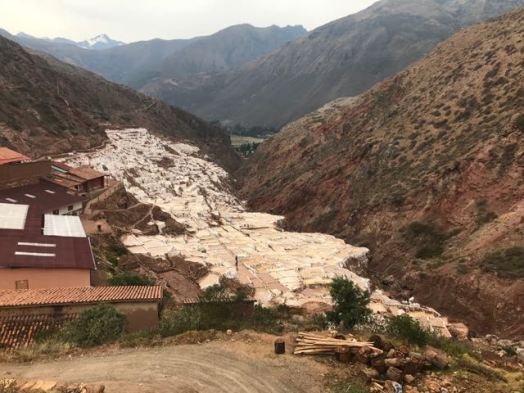
Next we visit Moras, where the Incans built ponds to evaporate salt from spring water that passes over a massive block of salt underground. The salt is left over from when the ocean covered this area eons ago, during the time of Pangaea. Controlling salt was a way to control people, and the Incas were not the only civilization to use such practices. The world salary comes from the Roman word salt, which was used as a form of money. The ponds are now owned by families who work together to harvest the salt. I watch a woman in knee-high rubber boots, wading in the 3-4 inch deep beige pond with white sides, holding a rake-like tool to pile salt in mounds so it can be bagged later. It sure looks like hard work in a harsh environment! A family owns 2 or 3 ponds. I love what Valentin tells us about the cost of our entry ticket- it goes directly to the families instead of to buy expensive wine for the president- the way the ticket to Machu Picchu does. Later he thanks us for having him as a guide and comments that hiring local guides for tours help put children through school and feeds families. I am so touched by how deeply he cares for his community. I dip my finger into the sparkling stream of warm water that flows through the channel into one pool. It’s saltiness is intense- saltier than anything I’ve ever tasted- and creates a pucker sensation that explodes in my mouth. I don’t want a second sample!



I won’t go into such detailed accounting of the other outings we had, but they were equally as rich and interesting. We visited Incan ruins near the village of Pisac, walked through two local markets, visited an elementary school where we distributed supplies for the children, and took a tour of Valentin’s family farm where we were treated to a delicious bounty of food from his garden, participated in a ceremony, and went for a beautiful hike with a gorgeous view. All the views are gorgeous!! I will tell more of those stories in the captions below the photos. Our last night at Sach’a Munay included Valentin’s chef preparing a feast for us in the traditional Pachamanca- an underground oven that cooks everything super fast. Traditionally they eat guinea pig, one of the animals domesticated by the Incas, so I tried some. It was actually quite delicious, though there wasn’t much meat on the piece I got. I loved all the different potatoes and roots!
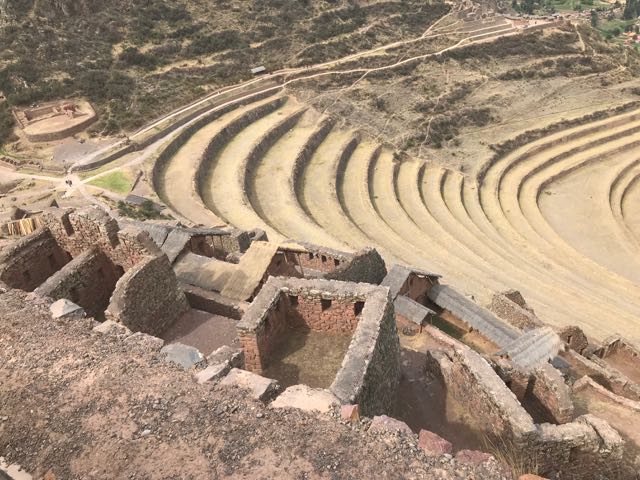
Market at Calca
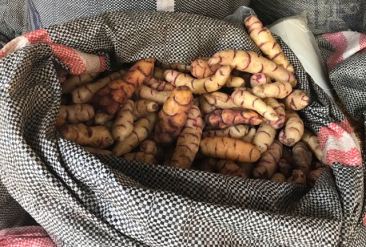


As we left Sach’a Munay I felt as if I was leaving my home. I think a lot of us did. It was a spacious place where we could settle in beautiful, peaceful surroundings and have plenty of places to spread out to write, reflect, relax in the sun, swing in hammocks, and even take a lovely hike to a nearby waterfall. Money from the tourists who stay there goes back into the community to support the school we visited, among other things. They buy some produce from the school gardens, which also helps to support education in the community. I found out that the owner is a man from Europe (I think it was Denmark) who bought the grounds to provide a retreat center where everyone is treated well- no yelling at staff, everyone paid well, etc. The feeling of well-being permeates the land and gave us all a healing backdrop to gel together as a group. I want to see more places like this- and even have a thought that maybe it’s in my future to help create or manage or be part of something like it some day….. In any case, I am absolutely in love with Peru!!
Market at Pisac
Pachamanca meal preparations:



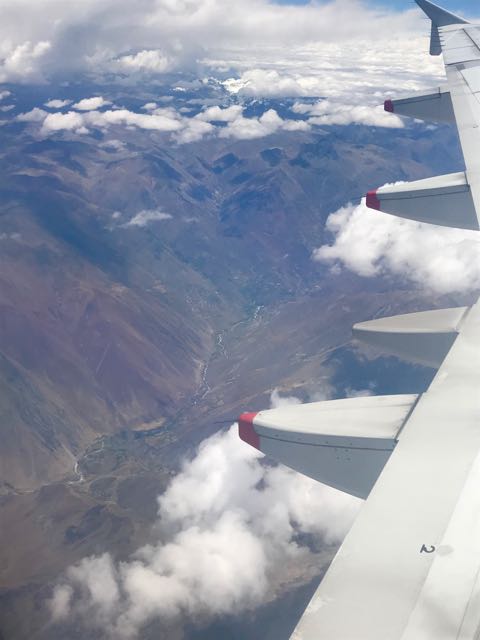

Tour of Valentin’s farm
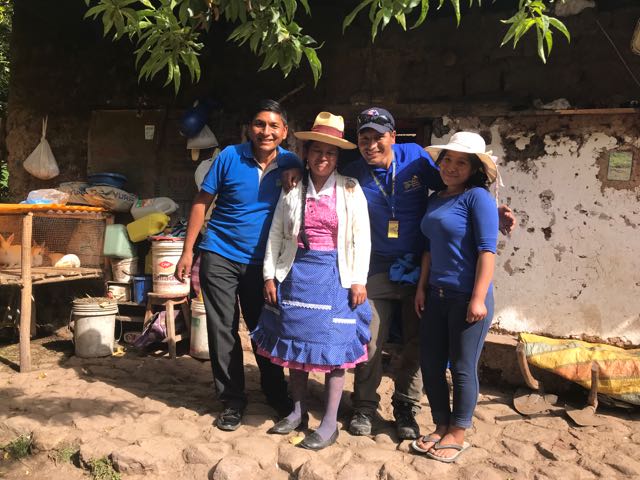



















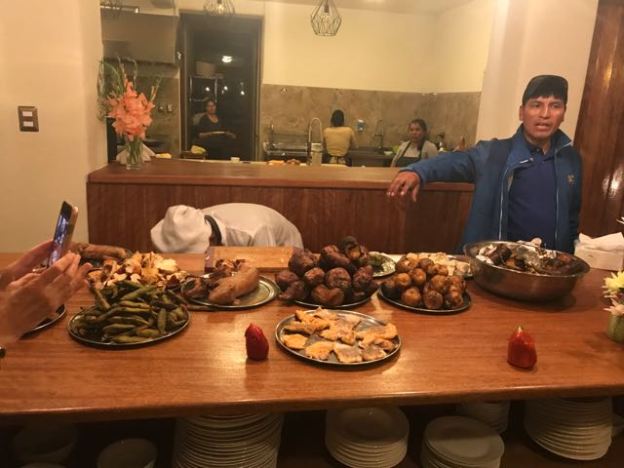


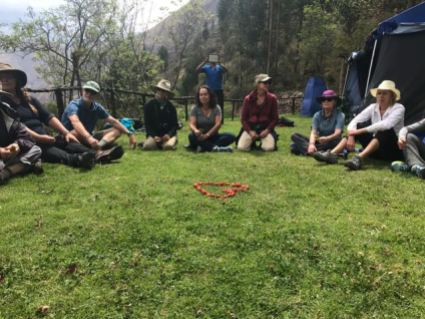

Wow, what a gorgeous place!
LikeLike
magical, mystical, colorful – love the incredibly diverse food culture.
LikeLike